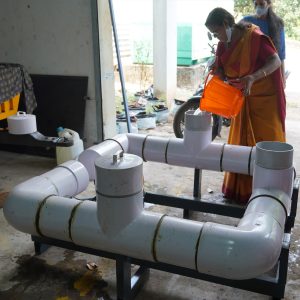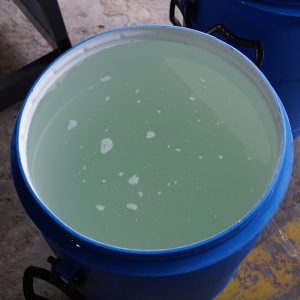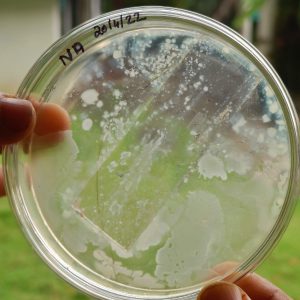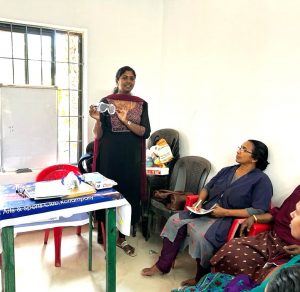ഡിവിഷനെക്കുറിച്ച്
എൻ സി ആർ എം ഐ കെമിക്കൽ ഡിപ്പാർട്ട്മെന്റ് എൻ സി ആർ എം ഐയുടെ ലാബ് ബ്ലോക്കിലാണ് പ്രവർത്തിക്കുന്നത്. പരിസ്ഥിതി സൗഹൃദമായ പ്രോസസ്സിംഗ് ടെക്നിക്കുകൾ ഉപയോഗിച്ച് പരീക്ഷണങ്ങളിലൂടെയും ട്രയലുകളിലൂടെയും ഇൻസ്റ്റിറ്റ്യൂട്ടിന്റെ പ്രോജക്ടുകൾ, ഉൽപ്പന്നങ്ങൾ അല്ലെങ്കിൽ സാങ്കേതിക വിദ്യകൾ എന്നിവയുടെ വികസനത്തിന് കെമിക്കൽ വിഭാഗം പ്രധാന പങ്ക് വഹിക്കുന്നു
കയർ നാരുകളുടെയും ചകിരിച്ചോറുകളുടെയും അനുബന്ധ ഉൽപന്നങ്ങളുടെയും ഗുണനിലവാരം തുടർച്ചയായി പരിശോധിക്കാൻ കെമിക്കൽ വിഭാഗത്തിലെ ടെസ്റ്റിംഗ് ലബോറട്ടറി സജ്ജമാണ്. കയർ നാരുകളുടെയും ചകിരിച്ചോറുമായി ബന്ധപ്പെട്ട ഉൽപന്നങ്ങളുടെയും ഭൗതിക-രാസ സ്വഭാവത്തിന്റെയും അടിസ്ഥാനത്തിൽ കെമിക്കൽ വിഭാഗം ടെസ്റ്റിംഗ് സേവനങ്ങൾ ബാഹ്യ ഉപഭോക്താക്കൾക്ക് നൽകുന്നു. വ്യവസായങ്ങൾക്കും സൊസൈറ്റികൾക്കും പ്രവർത്തനക്ഷമമായ സാങ്കേതിക വിദ്യകൾ വികസിപ്പിക്കുന്നതിനുള്ള പ്രധാന പദ്ധതികളുമായി വകുപ്പ് സദാ സജീവമാണ്
കോക്കൊഓറ എയർ ഫ്രഷ്നർ
പരമ്പരാഗതമായി നമ്മൾ ഉപയോഗിച്ചുകൊണ്ടിരിക്കുന്ന കെമിക്കലുകൾ അടങ്ങിയ എയർ ഫ്രഷ്നറുകൾക്ക് പകരമായി തീർത്തും വിഷരഹിതമായ ഒരു എയർ ഫ്രഷ്നറാണ് എൻ സി ആർ എം ഐ വികസിപ്പിച്ചെടുത്ത കൊക്കോഓറ. ഇത് തീർത്തും പ്രകൃതിദത്തമായ നമ്മുടെ ചകിരിച്ചോറും സസ്യങ്ങളിൽ നിന്നും വേർതിരിച്ചെടുക്കുന്ന എസ്സെൻഷ്യൽ ഓയിലും കൊണ്ട് നിർമ്മിച്ചിരിക്കുന്നതിനാൽ വീടുകളിലും കാറുകളിലും ജോലിസ്ഥലങ്ങളിലും കുട്ടികൾ സമയം ചിലവഴിക്കുന്ന സ്ഥലങ്ങളിലുമെല്ലാം വളരെ സുരക്ഷിതമായി ഉപയോഗിക്കാം എന്നുള്ളതാണ് ഇതിനെ വേറിട്ട് നിർത്തുന്നത്. ചകിരിച്ചോറിൽ നിന്നും നിർമ്മിതമായതു കൊണ്ടു തന്നെ ഉപയോഗ ശേഷം ഇത് മണ്ണിൽ അലിഞ്ഞ് ചേർന്ന് പരിസ്ഥിതി മലിനീകരണത്തിന് കാരണമാകുന്നില്ല എന്നുള്ളതും ഇതിന്റെ പ്രത്യേകതയാണ്. നിയന്ത്രിത റിലീസ് ഡിഫ്യൂഷൻ മെക്കാനിസം കൊക്കോ ഓറയെ ദീർഘകാലം സുഗന്ധം നിലനിർത്താൻ പ്രാപ്തമാക്കുന്നതിനാൽ മറ്റുള്ള എയർഫ്രഷ്നറുകളെ അപേക്ഷിച്ച് വളരെക്കാലം കൊക്കോ ഓറ ഉപയോഗിക്കാൻ സാധിക്കുന്നു. പൂർണ്ണമായും അലർജി ഉണ്ടാക്കാത്ത പൊടി രഹിതവും പരിസ്ഥിതി സൗഹാർദ്ദവും ചോർച്ച രഹിതവുമായ പാക്കേജിംഗിലാണ് കൊക്കോ ഓറ വിപണനത്തിന് തയ്യാറാക്കിയിട്ടുള്ളത് . പേപ്പർ സാഷേ, സ്റ്റീൽ ക്ലിപ്പുകൾ, നെയ്ത കോട്ടൻ പൗച്ച്, മുള കൊണ്ടുള്ള കണ്ടൈനർ എന്നിവയാണ് ഇതിൽ ഉപയോഗിച്ചിട്ടുള്ളത്. സെഡാൻ, ഹാച്ച് ബാക്ക് എന്നീ വലിയ ക്യാബിൻ സ്പെയിസുള്ള എല്ലാ കാറുകൾക്കും അനുയോജ്യമായ വലിപ്പത്തിലും ഡ്രൈവറുടെ കാഴ്ച മറയ്ക്കാത്ത രീതിയിലുള്ളതുമായ കൊക്കോഓറ വളരെ എളുപ്പത്തിൽ ഉപയോഗിക്കാൻ സാധിക്കുന്നു. താലേറ്റുകൾ, പരാബെൻസ്, സൾഫേറ്റുകൾ എന്നിവ ഒന്നും തന്നെ അടങ്ങിയിട്ടില്ലാത്ത കൊക്കോഓറ ലബോറട്ടറിയിൽ പരീക്ഷിച്ച് സാക്ഷ്യപ്പെടുത്തിയ ഉൽപ്പന്നം കൂടിയാണ്. കൊക്കോഓറ ഗ്രാനുലേറ്റ്സ്, കൊക്കോഓറ ജെൽ, കൊക്കോഓറ ഫൈബേഴ്സ്, കാറുകളിൽ ഘടിപ്പിക്കാവുന്ന വെന്റ് ക്ലിപ്സ് , കൊക്കോഓറ സാഷേയ്സ് എന്നീ അഞ്ച് വ്യത്യസ്ത തരങ്ങളിലും വിവിധ ഇനം സുഗന്ധങ്ങളിലും കൊക്കോഓറ ഇപ്പോൾ ലഭ്യമാണ്. നമ്മുടെ താൽപര്യമനുസരിച്ച് ഇതിന്റെ മണം ഇഷ്ടാനുസൃതം മാറ്റാം എന്നതും കൊക്കൊഓറയെ മറ്റുള്ള ഉത്പന്നങ്ങളിൽ നിന്നും വ്യത്യസ്തമാക്കുന്നു.
റെറ്റ് ലിക്ക്വർ സംസ്കരിക്കുന്നതിനുള്ള രാസ, ജൈവ പ്രക്രിയകളുടെ വികസനം
നാളികേരത്തിന്റെ തൊണ്ടിൽ നിന്ന് ചകിരി നാരുകൾ വേർതിരിച്ചെടുക്കുന്ന, പരമ്പരാഗത രീതിയായ തൊണ്ട് വെള്ളത്തിൽ കുതിർത്ത്, നാരുകൾ വേർതിരിക്കുന്ന റെറ്റിങ് പ്രക്രിയ സമയമെടുക്കുന്നതാണ്. മാത്രമല്ല ഉപോൽപ്പന്നമായി റെറ്റിങ് ജലവും ലഭിക്കുന്നു. ഈ ജലം പരിസ്ഥിതി മലീനീകരണത്തിന് കാരണമാകുന്നു. എന്നാൽ മെക്കാനിക്കലായി ചകിരി നാരുകൾ വേർതിരിക്കുന്നത് ഈ പരമ്പരാഗത രീതിയെക്കാളും വേഗത്തിലും പരസ്ഥിതി സഹാർദ്ദമായുമുള്ള ഒരു ബദൽ സംവിധാനമാണ്. ഇത്തരത്തിൽ വേർതിരിച്ച പരുപരുത്ത ചകിരി നാരുകൾ നല്ല തവിട്ട് നിറമുള്ളതും ഓക്സഡൈസ് ചെയ്യാൻ കഴിയുന്നവയുമാണ്. ഡിഫൈബറിംഗ് ചെയ്തെടുത്ത നാരുകൾ 24 മണിക്കൂർ ജലത്തിൽ കുതിർക്കുന്നത് ഭാരം കുറയുന്നതിനും ദൃഢമായ ഘടനക്കും കാരണമാകുന്നു. ഇങ്ങനെ ലഭിക്കുന്ന ജൈവാംശം കലർന്ന തവിട്ട് നിറത്തിലുള്ള ജലത്തെയാണ് റെറ്റ് ലിക്ക്വർ എന്ന് വിളിക്കുന്നത്. ഇത് പരിസ്ഥിതി മലിനീകരണത്തിന് കാരണമാകുന്നതാണ്.
ഫെർമെനന്റുകൾ ഉപയോഗിച്ചുള്ള ജൈവ സംസ്കരണ രീതി പരീക്ഷിച്ച് പ്രയോഗിച്ചതിലൂടെ ഒരു ഡബിൾ-ചേംബർഡ് ഫെർമെന്റർ ഡിസൈൻ, റെറ്റ് ലിക്ക്വറിന്റെ ബയോളജിക്കൽ ഓക്സിജൻ ഡിമാൻഡ്) (ബി ഒ ഡി) കുറയുന്നതായി മനസ്സിലാക്കാൻ കഴിഞ്ഞു. ഈ ജൈവ സംസ്കരണത്തിന് ആവശ്യമായ മിശ്രിതമുണ്ടാക്കാൻ ചാണക സ്ലറി,മോര് കൂടാതെ കടലാസ് ഫാക്ടറിയിൽ നിന്നുള്ള എഫ്ലുവന്റ്സ് എന്നിവയാണ് ഉപയോഗിക്കുന്നത്. ഇതിൽ നിന്ന് നിർമ്മിക്കുന്ന ബയോ ഇനോക്കുലം ഉപയോഗിച്ചാണ് റെറ്റ് ലിക്വറിനെ സംസ്കരിക്കുന്നത്. തുടർന്ന് ചിരട്ട ചീളികൾ ഉപയോഗിച്ച് ഫിൽട്ടർ ചെയ്ത് ശൂദ്ധീകരിക്കുന്നു. ഇനോകുലം സ്രോതസ്സുകളുടെയും ശുദ്ധീകരിച്ച ജലത്തിന്റെയും ഗുണനിലവാരത്തിന്റേയും കൂടുതൽ വിശകലനത്തിനും പഠനത്തിനും ഈ സംസ്കരണ രീതി ഉപയോഗിക്കുന്നു
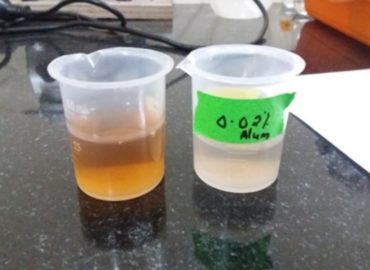
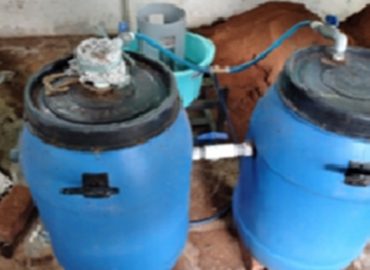
കയർ നാരുകളുടെ നിറവും ഘടനയും വർദ്ധിപ്പിക്കുന്നതിനുള്ള ജൈവ രാസ സംസ്ക്കരണ രീതി
ജൈവ രാസ സംയോജന രീതിയിലൂടെ കൂടൂതൽ ദൃഢവും ഗുണമേന്മയുമുള്ള ചകിരി നാരുകൾ ഉൽപാദിപ്പിക്കാൻ സാധിക്കുന്നു. റെറ്റിങ് സമയം പരമാവധി കുറച്ച് പരിസ്ഥിതി സൗഹാർദ്ദപരമായി കയർ ഫൈബർ ഘടന മെച്ചപ്പെടുത്തുന്നതിനായി എൻ സി ആർ എം ഐ വികസിപ്പിച്ച കെമിക്കൽ സോഫ്റ്റനർ ട്രയൽ പരീക്ഷണങ്ങളിലൂടെ ഉറപ്പാക്കിയിരിക്കുന്നു.

കയർ റെറ്റ് ലിക്വറിന്റെ രാസ സംസ്ക്കരണത്തിലൂടെയുള്ള മൂല്യ വർദ്ധനവ്
പരമ്പരാഗത രീതിയിൽ തൊണ്ട് ജലത്തിൽ കുതിർത്തതിനു ശേഷമാണ് ചകിരി വേർ തിരിക്കുന്നത്. ഇങ്ങനെ ഉണ്ടാകുന്ന ജലത്തിൽ ധാരാളം പെക്റ്റിൻ, പെന്റോസാൻ, കൊഴുപ്പ്, ടാന്നിൻസ്, വിഷാംശമുള്ള ഫിനോൾ എന്നീ ജൈവ പദാർത്ഥങ്ങൾ അടങ്ങിയിരിക്കുന്നു, ഇത് ജല വായു മലിനീകരണത്തിന് കാരണമാകുന്നു. മാത്രമല്ല സസ്യജന്തു ജാലങ്ങളെ പ്രതികൂലമായി ബാധിക്കുന്നു. രാസ പ്രക്രിയക്ക് വിധയമാക്കിയ ശേഷമുള്ള കയർ റെറ്റ് ലിക്ക്വറിന്റെ മുല്യവർദ്ധവിനെ കുറിച്ചുള്ള പഠനവും ഇതിന്റെ ഭാഗമാണ്
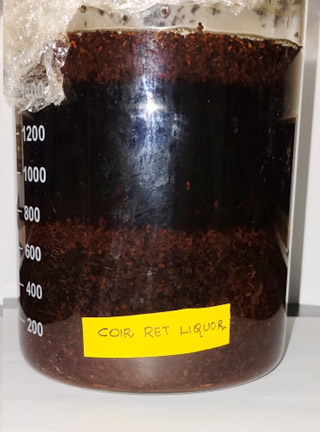
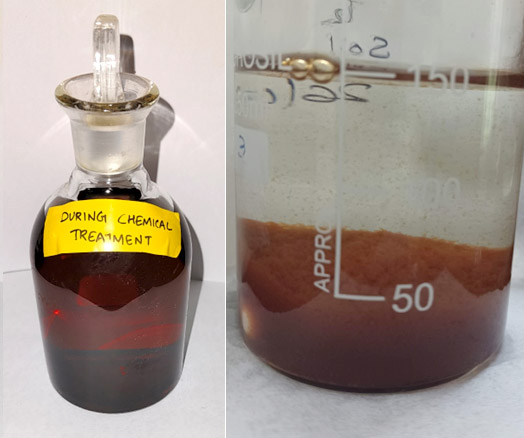
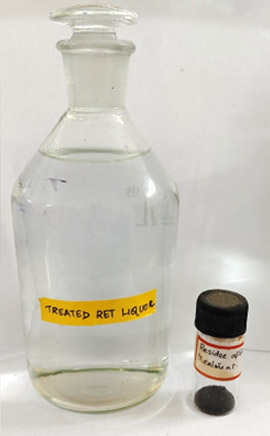
മലിനജലം ശുദ്ധീകരിക്കുന്നതിനായി കയർ അധിഷ്ടിത ബയോഫിലിം വികസിപ്പിക്കൽ
മലിനജലം പുനരുപയോഗം ചെയ്യുന്നതിനാണ് ഈ പദ്ധതി ശ്രദ്ധ കേന്ദ്രീകരിക്കുന്നത്. സാധാരണ രാസകീയമായ രീതിയീലാണ് മലിന ജലം ശുദ്ധീകരിക്കുന്നത്. എന്നാൽ എൻ സി ആർ എംയിലെ മൈക്രൊബയോളജി വിഭാഗം തികച്ചും പരിസ്ഥിതി സൗഹാർദ്ദപരമായ കയർ അടിസ്ഥാനമാക്കിയുള്ള ബയോഫിലിം വികസിപ്പിച്ചെടുത്തു. ഇതിലൂടെ മലിനജലം ശുദ്ധീകരിച്ച് പുനരുപയോഗം സാധ്യമാക്കുന്ന പദ്ധതിയുടെ വികസനമാണ് ഉദ്ദേശിക്കുന്നത്. ശുദ്ധീകരിച്ച കയർ അധിഷ്ഠിത ബയോമാസ് കാരിയറാണ് ബയോഫിലിം നിർമ്മാണത്തിനുപയോഗിക്കുന്നത്. ലബോറട്ടറികളിലെ സങ്കീർണ്ണതകൾ എൻ സി ആർ എം ഐ വികസിപ്പിച്ച ബയോഫിലിമിനില്ല എന്നുള്ളതാണ് ഇതിന്റെ സവിശേഷത. ഗതാഗത യോഗ്യമായ ഒരു മിനി-സ്കെയിൽ ട്രീറ്റ്മെന്റ് പ്ലാന്റിന്റെ വികസനത്തിലൂടെ, സാധാരണ മൈക്രോബയോളജിക്കൽ, കെമിക്കൽ വിശകലനങ്ങളുടെ സഹായത്തോടെ ഫലപ്രദമായി മലിന ജല സംസ്കരണം സാധ്യമാവുന്നു.
പോളിമർ കെമിസ്ട്രിയുടെ ഇൻഫ്രാസ്ട്രക്ചർ ഫെസിലിറ്റി ഡിവിഷൻ
ചകിരിച്ചോറ്, നാരുകൾ, അനുബന്ധ ഉൽപ്പന്നങ്ങൾ എന്നിവയുടെ രാസ പരിശോധനയ്ക്ക് അത്യാധുനിക കെമിക്കൽ ലബോറട്ടറി സൗകര്യങ്ങൾ എൻ സി ആർ എം ഐയിലെ കെമിക്കൽ വിഭാഗത്തിൽ സജ്ജീകരിച്ചിട്ടുണ്ട്. ഇത്തരം പരിശോധനകളിലൂടെ കയറിന്റെ ഗുണനിലവാരം, പരിശുദ്ധി, അനുയോജ്യത എന്നിവ വ്യത്യസ്ത കയർ ആപ്ലിക്കേഷനുകളിലേക്കായി പ്രയോജനപെടുത്താൻ സഹായിക്കുന്നു. ഡിവിഷനിലെ എല്ലാ പരിശോധനകളും ഐ എസ് മാനദണ്ഡത്തിന്റെ അടിസ്ഥാനത്തിലാണ് നടത്തുന്നത്
 |
കെജെൽദാൽ ആസിഡ് ഡയജഷൻജൈവവസ്തുക്കളിലും, മലിന ജലത്തിലും, മണ്ണിലും, ഭക്ഷണ പദാർത്ഥങ്ങളിലും, നാരുകളിലും ചകിരിച്ചോറിലും അടങ്ങിയിരിക്കുന്ന ആകെ നൈട്രജന്റെ അളവ് നിർണ്ണയിക്കാൻ ഉപയോഗിക്കുന്ന ഉപകരണം. |
 |
ഓട്ടോമാറ്റഡ് ഡിസ്റ്റലേഷനും, ടൈറ്റ്ട്രേഷൻ സംവിധാനംസാമ്പിളുകളിൽ അടങ്ങിയിരിക്കുന്ന നൈട്രജൻ സംയുക്തങ്ങളെ വേർതിരിക്കാനും അവയുടെ അളവ് തിട്ടപ്പെടുത്താനും ഉപയോഗിക്കുന്ന സംവിധാനമാണ് ഓട്ടോമാറ്റഡ് ഡിസ്റ്റലേഷൻ. ഒരു സ്റ്റാൻഡേർഡ് ലായനിയുടെ നിയന്ത്രിത കൂട്ടിച്ചേർക്കലിലൂടെ രാസ സംയുക്തങ്ങളുടെ അളവ് വിശകലനത്തിനായി ഓട്ടോമേറ്റഡ് ടൈറ്ററേഷൻ സിസ്റ്റം ഉപയോഗിക്കുന്നു. |
 |
ഓട്ടോമാറ്റിക് ഫൈബർ എസ്റ്റിമേഷൻ സിസ്റ്റംന്യൂട്രൽ ഡിറ്റർജെന്റ് ഫൈബർ (എൻ.ഡി.എഫ്), ആസിഡ് ഡിറ്റർജെന്റ് ഫൈബർ (എ.ഡി.എഫ്), ആസിഡ് ഡിറ്റർജെന്റ് ലിഗ്നിൻ, (എ.ഡി.എൽ) സെല്ലുലോസ്, ഹെമിസെല്ലുലോസ്, സസ്യവസ്തുക്കളിലെ ലിഗ്നിൻ, കോമ്പൗണ്ട് ഫീഡ്, ഫുഡ് സാമ്പിളുകൾ എന്നിവയിൽ അടങ്ങിയിരിക്കുന്ന അസംസ്കൃത നാരുകളുടെ അളവ് നിർണ്ണയിക്കാൻ ഉപയോഗിക്കുന്ന ഉപകരണം. |
 |
കോൾഡ് എക്സ്ട്രാക്ഷൻ സിസ്റ്റംഎക്സ്ട്രാക്ഷനിലൂടെ ഫൈബർ ഡിഫാറ്റിംഗ് ചെയ്യുന്ന സംവിധാനം |
 |
pH സിസ്റ്റംസാമ്പിളുകളുടെ അസിഡിറ്റിയും ആൽക്കലിനിറ്റിയും തിട്ടപ്പെടുത്താൻ pH സിസ്റ്റം ഉപയോഗിക്കുന്നു. |
 |
ബെഞ്ച് ചാലകത/റ്റി ഡി എസ്/ലവണാംശം/താപനില മീറ്റർചാലകത, ലവണാംശം അല്ലെങ്കിൽ മറ്റ് അലിഞ്ഞു ചേർന്ന വസ്തുക്കളുടെ വസ്തുക്കളുടെ സാന്നിധ്യം എന്നിവയും ഈ ഉപകരണത്തിലൂടെ മനസ്സിലാക്കാൻ കഴിയും. |
 |
ഫ്ലയിം ഫോട്ടോമീറ്റർസോഡിയം (Na), പൊട്ടാസ്യം (K), ലിഥിയം (Li), കാൽസ്യം (Ca), മഗ്നീഷ്യം (Mg) എന്നിവയുടെ വിശകലനത്തിനായി ഉപയോഗിക്കുന്നു. |
 |
യുവി-സ്പെക്ട്രോഫോട്ടോമീറ്റർസാമ്പിളുകളിലെ രാസഘടന നിർണ്ണയിക്കുന്നതിനുള്ള ഉപകരണം. |
 |
മഫിൽ ഫർണസും ഹോട്ട് എയർ ഓവനുംചൂടാക്കുന്നതിനും താപ സംസ്കരണത്തിനും വേണ്ടി ഉപയോഗിക്കുന്ന ഉപകരണം. |
 |
റോട്ടറി ഷേക്കർവിവിധ രാസ, ജൈവ ആപ്ലിക്കേഷനിലൂടെ സാമ്പിളുകൾ ഇളക്കി കൂട്ടി ചേർത്ത് മിശ്രിതമാക്കാൻ ഉപയോഗിക്കുന്നു. |
കെ സി സി പി എല്ലിന് വേണ്ടി ചകിരിച്ചോറ് കമ്പോസ്റ്റിംഗിന്റേയും ഗാർഹിക കമ്പോസ്റ്റിന്റേയും പരിശീലനം - ചകിരിച്ചോറിന്റെ രാസ സവിശേഷതകളെക്കുറിച്ചുള്ള സെമിനാർ
കെ സി സി പി എല്ലിന് ചകിരിച്ചോറ് കമ്പോസ്റ്റിംഗും ഗാർഹിക കമ്പോസ്റ്റിംഗും സംബന്ധിച്ച് പരിശീലനം നൽകുന്നതിന് വേണ്ടി സെമിനാർ നടത്തുകയുണ്ടായി. നാളികേര വ്യവസായത്തിന്റെ ഉപോൽപ്പന്നമായ ചകിരിച്ചോറിന്റെ രാസ ഗുണങ്ങളെക്കുറിച്ചുള്ള അറിവ് പകരുക എന്നതായിരുന്നു സെമിനാറിന്റെ ലക്ഷ്യം. ചകിരിച്ചോറിന്റെ പരിസ്ഥിതി സൗഹൃദ സ്വഭാവം പ്രയോജനപ്പെടുത്തി കൊണ്ട് ചകിരിച്ചോറ് കമ്പോസ്റ്റ് ചെയ്യുന്നതിനുള്ള ഫലപ്രദമായ മാർഗ്ഗങ്ങളെക്കുറിച്ച് പ്രതിനിധികൾക്ക് ബോധവൽക്കരണം നൽകുകയുണ്ടായി. ചകിരിച്ചോറിന്റെ രാസഘടന മനസ്സിലാക്കുക, സൂക്ഷ്മജീവികളുടെ പ്രവർത്തന സാഹചര്യങ്ങൾ മെച്ചപ്പെടുത്തുക, ശരിയായ ഗാർഹിക കമ്പോസ്റ്റിംഗ് രീതികൾ ഉറപ്പാക്കുക എന്നിവ ഉൾപ്പെടെ കമ്പോസ്റ്റിംഗ് സംബന്ധിച്ച പ്രധാന വശങ്ങൾ പരിശീലനത്തിൽ ഉൾപ്പെടുത്തിയിട്ടുണ്ട്. പാരിസ്ഥിതിക സുസ്ഥിരത വർധിപ്പിക്കുക, മാലിന്യ നിർമാർജനം പ്രോത്സാഹിപ്പിക്കുക, കാര്യക്ഷമവും ഉത്തരവാദിത്തമുള്ളതുമായ കമ്പോസ്റ്റിംഗിന് ആവശ്യമായ ശാസ്ത്രീയമായ അറിവുകൾ പകർന്നു കൊണ്ട് കെ സി സി പി എല്ലിലെ വ്യക്തികളെ ശാക്തീകരിക്കുക എന്നിവയാണ് ഈ സെമിനാർ ലക്ഷ്യമിടുന്നത്.
എൻ സി ആർ എം ഐ-കെമിക്കൽ ഡിവിഷൻ നടത്തിയ ഫ്രെയിം മാറ്റുകളുടെ പരിശീലനവുമായി ബന്ധപ്പെട്ട് വിവിധ CVS കളിലെ കയർ തൊഴിലാളികൾക്ക് കെമിക്കൽസ് കൈകാര്യം ചെയ്യുന്നതിനുള്ള ആരോഗ്യ സുരക്ഷാ നടപടികളെക്കുറിച്ച് നൽകിയ പരിശീലനം.
കയർ നാരുകൾ ബ്ലീച്ച് ചെയ്യുന്നതും ഡൈ ചെയ്യുന്നതുമായ പ്രക്രിയകളിൽ രാസവസ്തുക്കൾ കൈകാര്യം ചെയ്യുന്നതുമായി ബന്ധപ്പെട്ട ആരോഗ്യ-സുരക്ഷാ പ്രോട്ടോക്കോളുകളെക്കുറിച്ചുള്ള അവബോധവും ധാരണയും വർദ്ധിപ്പിക്കുന്നതിനാണ് പരിശീലന പരിപാടി സംഘടിപ്പിച്ചത്, പ്രത്യേകിച്ച് ഫ്രെയിം മാറ്റുകൾ നിർമ്മിക്കുന്നതിന് കയർ ഉൽപന്നങ്ങളുടെ ഗുണ നിലവാരം നിലനിർത്തിക്കൊണ്ട് സുരക്ഷിതമായ തൊഴിൽ അന്തരീക്ഷം ഉറപ്പാക്കുന്നതിന് ആവശ്യമായ അറിവും വൈദഗ്ധ്യവും കയർ തൊഴിലാളികൾക്ക് പകർന്ന് നൽകി അവരെ സജ്ജരാക്കുകയാണ് ഈ പരിശീലനത്തിന്റെ ഉദ്ദേശ ലക്ഷ്യം.
- ശ്രീ അഭിഷേക് സി, സയന്റിസ്റ്റ് - എസ് 3
- ശ്രീമതി സ്വാതി കൃഷ്ണ വി. എസ്, ടെക്നിക്കൽ ഓഫീസർ (പോളിമർ കെമിസ്ട്രി)
COCOAURA – Fragrance, Nature’s Way
COCOAURA, an organic car freshener, was developed as a natural alternative to traditional chemical air fresheners. It is meticulously crafted from coir pith and fibre, natural materials sourced from coconut husk, and provides a safe, chemical-free way to energise interior areas. Even after the product's usable life expires, the used coir pith and fibre may find a second life enhancing gardening soil. The product is incredibly eco-friendly and produces no waste during manufacture. COCOAURA has antibacterial and antifungal properties in addition to controlled release diffusion capabilities. There are five different ways to get COCOAURA: granulates, fibres, gel, sachets, and vent clips.
Development of chemical and biological system to treat ret liquor
In the process of coir fiber extraction from coconut husks, the traditional method of retting, involving soaking the husks in water, is time-consuming and generates retted water as a by-product. Discharging this water improperly can lead to pollution. Mechanical extraction of coir fiber is a quicker alternative, but it results in bright-colored fiber that can oxidize and become brown and coarse. Soaking the fiber for 24 hours after defibring helps reduce lightfastness and improves texture. The washed water from this process, known as ret liquor, is brown due to the organic matter present and can be harmful if released into water bodies.
The study also explores the use of biological treatment using fermenters. A double-chambered fermenter design showed a reduction in BOD (Biological Oxygen Demand) of ret liquor. The system employs a mixture of cow dung slurry, cheese whey, and effluent from the paper industry as a source of bio-inoculum for anaerobic digestion of coir ret effluent, followed by filtration through coconut shell pieces. This treatment method holds promise for further analysis and standardization of inoculum sources and treated water quality.


Treatment of coir fibre with various biological and chemical agents to improve the texture and colour.
This study focuses a combined treatment (chemical and biological), that have a great potential to produce more consistent quality fibres with substantially reduced retting time and is more environmental friendly. To improve the coir fibre texture, trial experiments were conducted with a chemical softener developed by NCRMI.

Value addition of coir ret liquor with chemical methods
Soaking coconut husk in brackish water system for 6- 12 months is an old traditional practice carried out for the extraction of coir fibre from coconut husk. As a result of retting large quantities of organic substances including pectin, pentosan, fat, tannins, and also toxic phenols are liberated into water. All these processes contribute to pollution of water and air. This is reported to have devastating effect on the flora and fauna. This study focuses a combined chemical and biological methods should be environment friendly and economically viable treatment on ret liquor collected from various coir spinning societies.



Development of biofilm on coir based biomass carriers for treating effluent water
The golden theme of our project is to recycle the waste water effluent in a path of a sustainable way by using microbial biofilms of coir based products. There are many chemical and mechanical processes to carry over the treatment of waste water for reusing. This chemical process paves a way for an unhealthy environment. Coir is a hard and tough organic fibre which possesses high specific area and wetting ability makes use as a suitable substrate for biofilm complex aggregation of microorganisms on fixed film processes. The main attraction of the project is that, this treatment system can be easily portable to any conditions and economically viable. The research is under progression with different products.
Infrastructure facility division of polymer chemistry
NCRMI has highly sophisticated Chemical laboratory offers advanced resources for specialised chemical examination of coir pith, fibre, and associated products. These tests provide information about the quality, purity, and suitability of coir for different applications. Testing of coir and coir-related products was done in accordance with IS standards.
 Kjeldahl acid digestion
Kjeldahl acid digestion
Kjeldahl acid digestion is a commonly used method in analytical chemistry for the decomposition and digestion of organic compounds containing nitrogen. It is an essential step in the Kjeldahl method, which is employed to determine the total nitrogen content in various samples, such as coir pith, fibre, food, soil, wastewater, and biological materials.
 Automated distillation system for the estimation of nitrogen and titration system
Automated distillation system for the estimation of nitrogen and titration system
An automated distillation system for nitrogen estimation is used to separate and quantify nitrogen compounds in a sample.The entire distillation process can be automated using a dedicated instrument, which controls the heating, steam generation, condensation, and collection of the distillate. Automated titration system is used for the quantitative analysis of chemical compounds through controlled addition of a standardized solution. Automated systems often include sensors, data acquisition capabilities, and software for precise control and analysis of the results.
 Automatic fibre estimation system- for the determination of crude fibre, NDF, ADF, ADL, Cellulose, Hemicellulose. Lignin in plant materials, compound feed and food etc.
Automatic fibre estimation system- for the determination of crude fibre, NDF, ADF, ADL, Cellulose, Hemicellulose. Lignin in plant materials, compound feed and food etc.
An automatic fiber estimation system is a specialized instrument used for the determination of various fiber components in plant materials, compound feed, and food samples.Automatic fiber estimation systems offer several advantages, including increased efficiency, accuracy, and reproducibility compared to manual methods. They streamline the analysis process, reduce human error, and provide rapid and reliable results. These systems are commonly used in research and quality control laboratories in various industries, such as agriculture, animal feed production, and food processing, to assess the nutritional quality and composition of samples.
 Cold extraction system for defatting of fibre
Cold extraction system for defatting of fibre
Coir pith/ fiber may contain natural extractives, such as oils, resins, or tannins, which can impact its suitability for certain uses. Extractives analysis helps identify and quantify these substances present in the coir pith/fibre.
 pH system
pH system
The pH level of coir pith is an important parameter, especially when it is used as a growing medium. Testing the pH helps determine the acidity or alkalinity of coir pith and its potential impact on plant growth.
 Bench conductivity /TDS/Salinity/Temp. Meter
Bench conductivity /TDS/Salinity/Temp. Meter
Conductivity measurements are useful for assessing the quality and purity of coir pith, particularly in relation to its salt content or the presence of other dissolved substances.
 Flame photometer
Flame photometer
The flame photometer is primarily used for the analysis of alkali and alkaline earth metals, such as sodium (Na), potassium (K), lithium (Li), calcium (Ca), and magnesium (Mg present in the coir pith/fibre sample).
 UV-Spectrophotometer
UV-Spectrophotometer
A UV-visible spectrophotometer is a versatile analytical instrument that can be used to determine the chemical composition of elements in coir pith/fibre. It can be employed to determine the concentration of specific compounds or functional groups that are indicative of the chemical composition of the coir pith/fibre.
 Muffle furnace and Hot air oven
Muffle furnace and Hot air oven
Muffle furnace and Hot air oven are essential tools for preparing coir pith/fibre samples for subsequent analysis, such as determining the mineral content, moisture content, or other specific components of interest. The specific temperature and duration of heating in these instruments will depend on the analysis method, desired outcomes, and the characteristics of the coir pith/fibre sample being analyzed.
 Rotary Shaker
Rotary Shaker
A rotary shaker is a laboratory instrument used for the agitation and mixing of samples in various chemical and biological applications. In the chemical analysis of coir pith/fibre,a rotary shaker can be employed for Sample Extraction, Sample Homogenization, Reagent Mixing, Sample Incubation, Extraction of Soluble Components etc.
Training of coir pith composting and house holding composting to KCCPL : A seminar on the chemical characteristics of coir pith
A seminar was conducted to provide training on coir pith composting and household composting to KCCPL. The focus of the seminar was on imparting knowledge about the chemical characteristics of coir pith, a byproduct of the coconut industry. Participants were educated on effective methods for composting coir pith, emphasizing its eco-friendly nature. The training covered key aspects of composting, including understanding the chemical composition of coir pith, optimizing conditions for microbial activity, and ensuring proper household composting practices. This initiative aimed to enhance environmental sustainability, promote waste reduction, and empower individuals at KCCPL with the skills needed for efficient and responsible composting.
Training on health and safety measures in chemical handling for coir workers of various CVCS in connection with training on frame mats to coir societies conducted by NCRMI
The training program focused on enhancing awareness and understanding of health and safety protocols associated with the handling of chemicals during the processes of bleaching and dyeing of coir fibers, specifically to produce frame mats. The sessions aimed to equip coir workers with the necessary knowledge and skills to ensure a safe working environment while maintaining the quality standards of coir products.
- Sri Abhishek C, Scientist S3
- Smt Swathy Krishna V S, Technical Officer (Polymer Chemistry)




